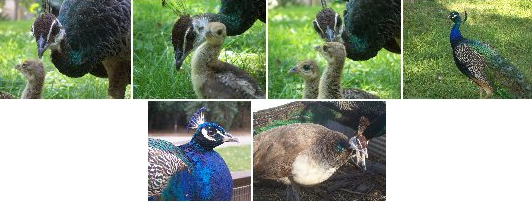 Other Names: India Blue Peafowl, Blue Peafowl, Common Peafowl
Other Names: India Blue Peafowl, Blue Peafowl, Common Peafowl
Subspecies: Monotypic, but a host of mutations exist.
Range: Pakistan, India and Sri Lanka. Many feral populations exist throughout the world.
Habitat: Varied, deciduous forests, cultivated lands and near villiages.
Description: Unmistakable, could only possibly be confused with the Green Peafowl. Males are large, with a long ornate tail used for courtship. Distinguishable from Pavo muticus in having a royal blue neck and breast; facial skin is white, crest is fan shaped. Immature males have varied plumage, but will have the fan-shaped crest and mottled blue upperparts. Second year males show a smaller tail, often without ocelli. By the third year, they reach full plumage and sexual maturity. The tail may continue to grow for another two to three years. Males will molt and lose their tails each year in late summer.
Description, Female: Rather drab in comparison to the male. Facial skin and crest shape same as in male, but crest is brown. The throat is white, breast and back of neck green; abdomen pale buff to cream, rest of body light brownish-gray.
Status in Wild: Very common in most areas of the natural range.
Interesting Facts: The National Bird of India. This species is sometimes simply called the Peacock; the peacock is the male, females are known as peahens and the young are peachicks. Pavo is Latin for peafowl. cristatus is Latin for crested. Peafowl have been kept in captivity for many centuries and have been reported in ancient Egyptian, Roman and Greek history.
Captive Diet: When on free range, will eat just about anything! A balanced diet should be offered to include poultry pellets and grain. Birds housed in aviaries should be offered greens and live food when available.
Breeding Season: Varies depending on region. In Missouri, can begin as early as March. Egg laying is usually complete by the time the males drop their tails in July, but there are exceptions!
Breeding Age: As a rule, males are not mature until their third year, but second year males are often fertile. I have heard of first year hens laying, but the second year is the average.
Clutch Size: Average clutch sizes in the wild are 6 to 8. Captive birds will lay up to three clutches.
Incubation Period: 28 days.




